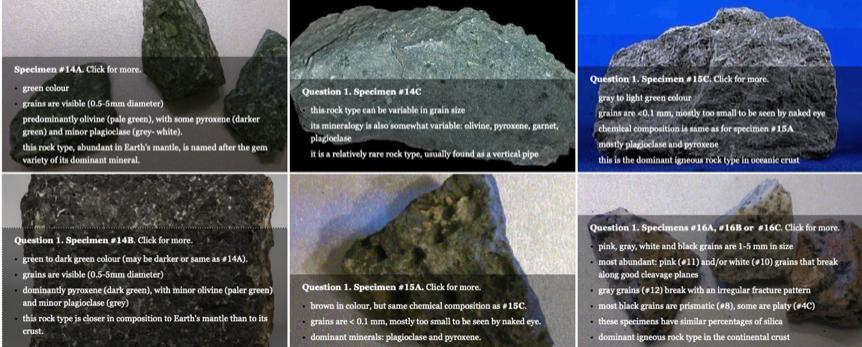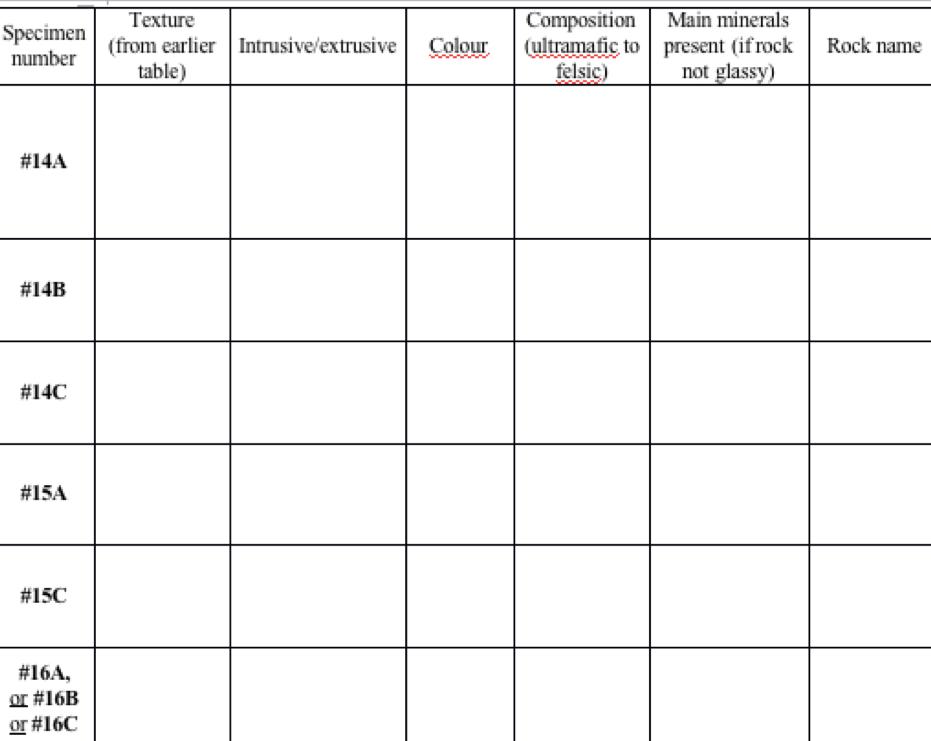Question
Fill out the table printed in the worksheet with the texture (e.g. aphanitic, phaneritic, porphyritic, vesicular, glassy), the extrusive or intrusive origin, the colors of
Fill out the table printed in the worksheet with the texture (e.g. aphanitic, phaneritic, porphyritic, vesicular, glassy), the extrusive or intrusive origin, the colors of the minerals present, the dominant composition (ultramafic, mafic, intermediate, felsic) suggested by the color the rock. List the main rock-forming minerals (click on the text of each specimen image for clues) and indicate the correct name of the rock type for the following specimens: #14A, #14B, #14C, #15A, #15C, and one of #16A, #16B or #16C.
The texture and rock names must come from the rock classification table given on the worksheet, but not every rock name or texture is illustrated by the specimens.
You may also find useful the descriptions linked to the following rock names.
ULTRAMAFIC rocks: komatiite, peridotite (and its variety, kimberlite), pyroxenite. Most of the Earth (its entire mantle) is ultramafic!
MAFIC: basalt, gabbro. The oceanic plates are mostly mafic (basaltic) in composition.
INTERMEDIATE: andesite, diorite. A common type of igneous rock composition found at convergent plate boundaries.
FELSIC: rhyolite, granite. The continental crust is mostly felsic (granitic) in composition.

Specimen #14A. Click for more. green colour grains are visible (0.5-5mm diameter) predominantly olivine (pale green), with some pyroxene (darker green) and minor plagioclase (grey-white). this rock type, abundant in Earth's mantle, is named after the gem variety of its dominant mineral. Question 1. Specimen #14B. Click for more. green to dark green colour (may be darker or same as #14A). grains are visible (0.5-5mm diameter) dominantly pyroxene (dark green), with minor olivine (paler green) and minor plagioclase (grey) this rock type is closer in composition to Earth's mantle than to its crust. Question 1. Specimen #14C this rock type can be variable in grain size its mineralogy is also somewhat variable: olivine, pyroxene, garnet, plagioclase it is a relatively rare rock type, usually found as a vertical pipe Question 1. Specimen #15A. Click for more. brown in colour, but same chemical composition as 15C. grains are < 0.1 mm, mostly too small to be seen by naked eye. dominant minerals: plagioclase and pyroxene. Question 1. Specimen #15C. Click for more. gray to light green colour grains are
Step by Step Solution
3.38 Rating (151 Votes )
There are 3 Steps involved in it
Step: 1
Specimen Texture Vesicular 14A 14B 14C 15A 15C 16A 16B 16C Mineral Extrus...
Get Instant Access to Expert-Tailored Solutions
See step-by-step solutions with expert insights and AI powered tools for academic success
Step: 2

Step: 3

Ace Your Homework with AI
Get the answers you need in no time with our AI-driven, step-by-step assistance
Get Started


